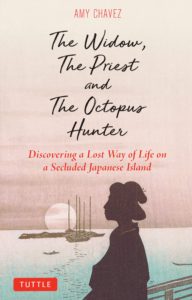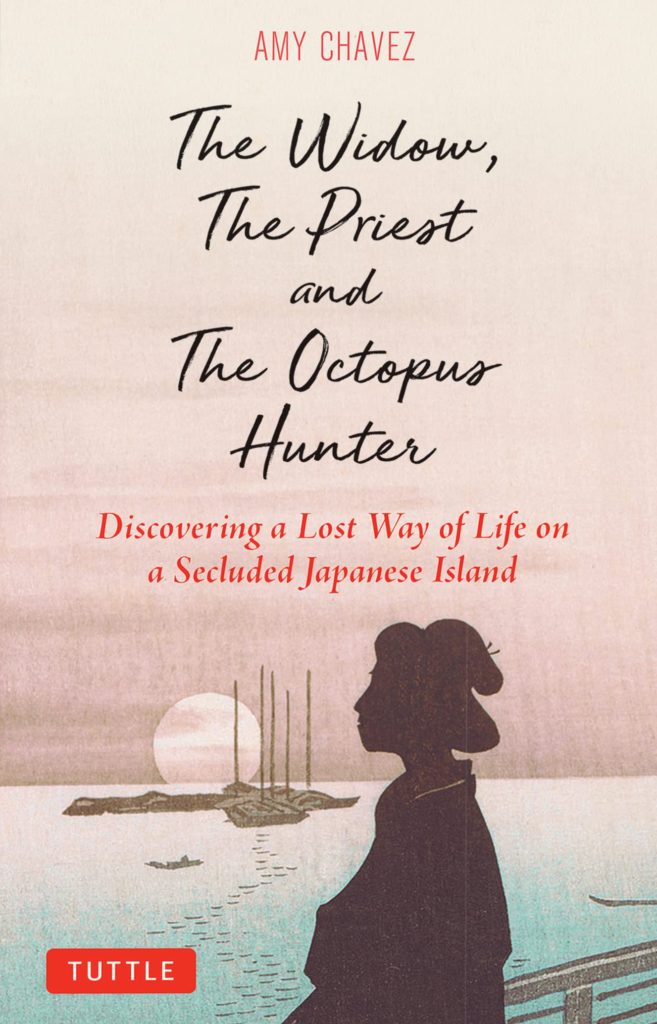The Widow, the Priest and the Octopus Hunter: Discovering a Lost Way of Life on a Secluded Japanese Island
Review by Tina deBellegarde
With The Widow, the Priest and the Octopus Hunter, Amy Chavez has presented us with a gift of cultural preservation. The author conducted a year-long oral history project on the Island of Shiraishi, the place she has called home for over twenty five years. In so doing, she has revealed to us a culture that has disappeared in most places in Japan and may soon disappear on Shiraishi as well. Not since Donald Richie’s The Inland Sea have we had the privilege of seeing first-hand the traditions, superstitions and folklore of a Japanese island culture that has all but died out.
At the heart of her journey was the quest to revive the memory of Eiko, a war widow, in whose home Chavez has lived for all these years. She met her but once and even attended her funeral, but the rest of the details of Eiko’s existence was lost on the author.
I became accustomed to living amongst the belongings of this woman I never knew…A woman whose presence was still keenly felt in the lacquered zelkova table I placed my tea cup on, in the wall-hanging of Mount Fuji at the end of the hallway, the hanging scroll in the tokonoma alcove and the picture of the Showa emperor, Hirohito, looking ominously down from the cornice of the ceiling (Page 24).
During those early years as a tenant, Chavez felt obliged to maintain all of Eiko’s personal items. The years passed, she purchased the home, but it wasn’t until a recent renovation that she sorted through it all with the intention of returning Eiko’s belongings to the family. Rather than a house cleaning project, Chavez discovered that by sorting through Eiko’s things, she felt closer to her and more curious. She set out to understand just who this woman was.
Although the goal was to learn about a specific person, what Chavez accomplished was a thorough oral history of the last one hundred years of Shiraishi Island. Through the introduction, we experience the dawning of the day on the island, and by the end of the chapter we are firmly planted on the island’s boulders and ready to meet the villagers. She interviews many residents: among them are two ferry captains who moonlight as Shinto priests, a Buddhist priest, an innkeeper, a postmaster, a tombstone cutter, four Chinese brides, and an octopus hunter.
We learn about fishing methods no longer in use, about the history of the quarry families, and about the festivals with their unique traditions and dances. Most of all we hear the voices of the individuals. We share tea or a beer with them as they reveal their most intimate moments, hopes, desires, and disappointments. We participate in their regret at the probable loss of this peaceful existence. Above all, we learn that these are not just individuals but members of a community, and it is the community that makes this island life so special. Residents who arrived sixty years ago are still considered outsiders.
With a diminishing and aging population, the closing of the school and the lack of a doctor, the writing is on the wall. While reluctant to accept change, they are also unable to stop it and too old to take on the burden of preservation.
The island life has lasted this long partly because of the yutaan (U-turn) movement of residents who left the island for jobs in the city then moved back in their retirement. Although not young, they are younger than their parents and able to extend the village lifestyle one diminishing generation after another. But soon, these will be too few to make a difference.
It’s worth noting that the Buddhist priest considers the most important moment of his ministry the end-of-year visits to the families.
“During those visits the old people talk to me. They want me to listen to their stories, so I do. And their stories are important. They are once-in-a-lifetime experiences and it’s sad that people will soon forget these things.” (Page 188).
For the last interview, Chavez selects the Stay-at-Home Dad very intentionally, for he is the only resident with children on the island, and he has a clear vision of the island’s future. He believes that remote work and a repurposing of buildings as affordable housing for younger people could be the future for Shiraishi. He leaves us with hope.
Her final chapter is an “interview” with the war widow Eiko. This is the crowning moment of the book; it is an entry in which Eiko speaks to us. Here Chavez has meticulously composed a fleshed-out picture of our war widow. The author uses the words and experiences of her neighbors to piece together who Eiko was, what her trials and tribulations were, and how she managed through the war and post-war difficulties on the secluded island.
In giving Eiko a voice she is also giving all war widows a voice.
We hear about the soldiers who returned, the kamikaze pilots who didn’t, the survivors of Hiroshima, Nagasaki and the Tokyo air raids. We read about POWs, the military police, the comfort women, and the pan-pan girls of the Occupation. We have heard about the Japanese women who married foreign soldiers and moved to their countries. But the war widows vanished from everyone’s consciousness, and remain disembodied voices of the past. Eiko was never meant to be seen. (Page 182).
Chavez has corrected this oversight.
As much as the oral history is fascinating and intimate, I found the Foreword, the Introduction, the Epilogue and the penultimate chapter about Chavez herself to be the most poignant, and the most immediate. Her love and appreciation of her surroundings is so deep, she captures the sights, smells and sounds so vividly, that she has made me nostalgic for a world I have never experienced.
Chavez reflects on her twenty-three years as a resident:
On this island, I have sat in the eye of a typhoon, seen how octopus are hunted, learned to dance under the moonlight, and wandered like the poet Basho on an ancient pilgrimage trail….Something prevents me from letting go of the past, Eiko’s past, with neighbors who still live it, who spend long afternoons chatting over tea, collecting seaweed, bracken and bamboo shoots, and where I can hear the distant bell of a rotary dial telephone. A place where time is measured not in years, but by the height of a Chinese fan palm, which is now taller than my house. (Page 213).
Some villagers still have hope that the island will draw people to its unusual existence. After all, it did draw Chavez, and she remains under its spell, and before very long, readers will be enthralled as well.


